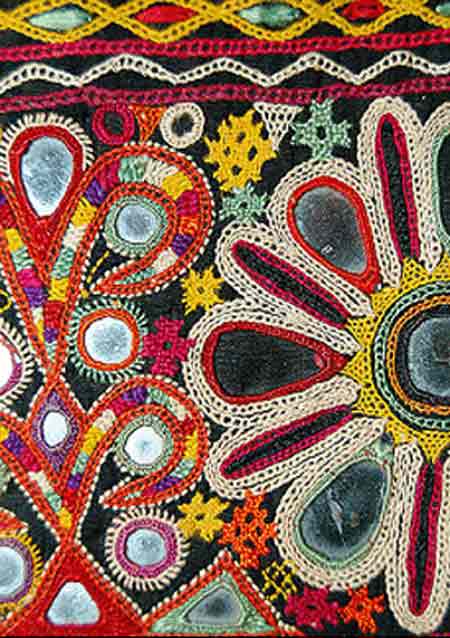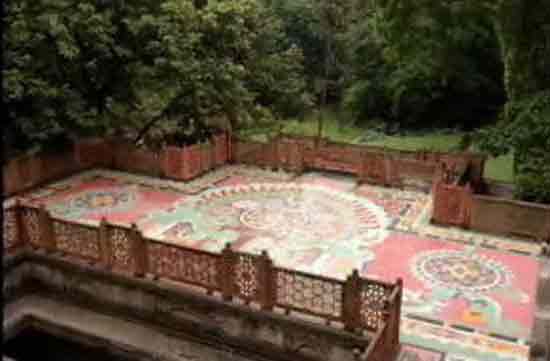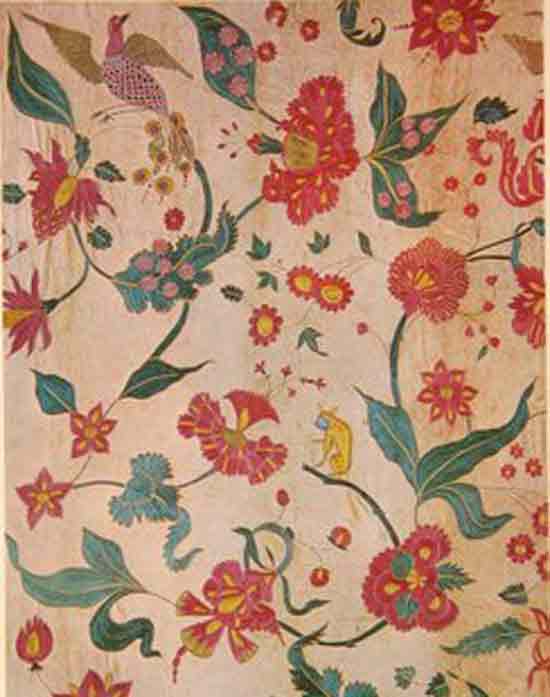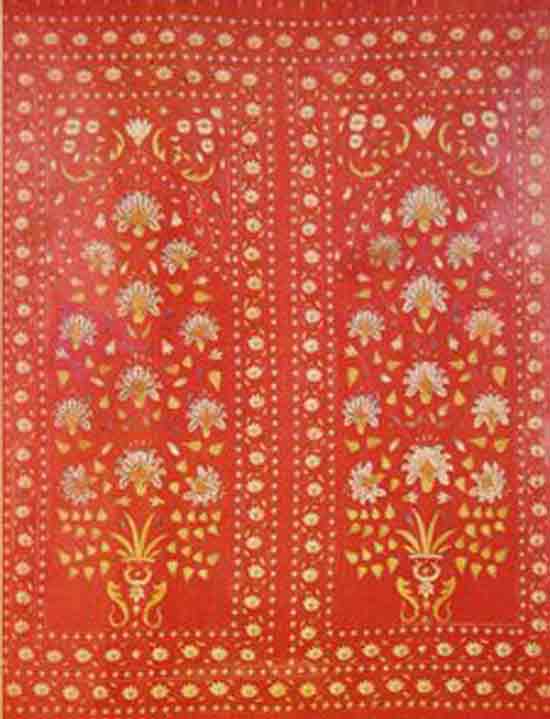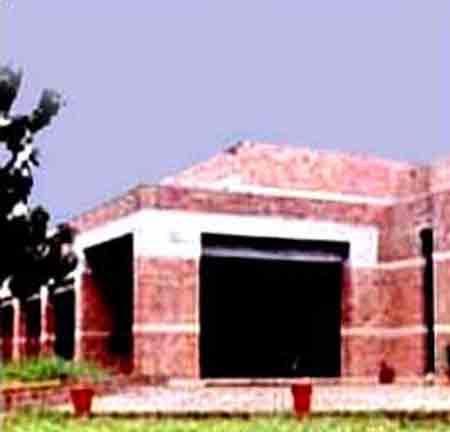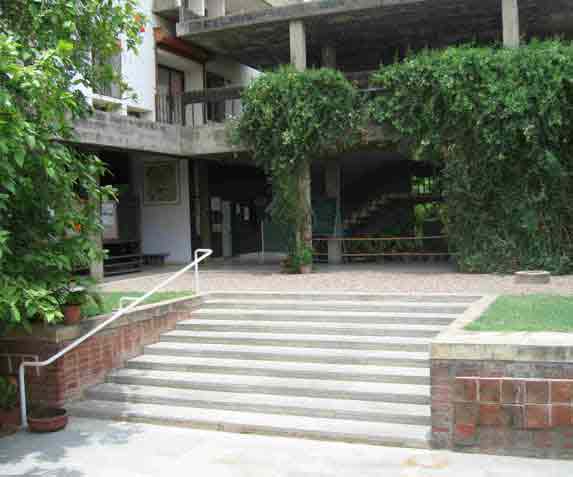Calico Museum of Textiles
Tuesday, 06 October 2009 03:56
Calico Museum of Textiles-Ahmedabad |
About: |
|
The Calico Museum of Textiles is one of India's most celebrated textile museums and a prime tourist attraction in Ahmedabad, Gujarat. Established in 1949, the museum showcases an exquisite collection of Indian textiles, some of which date back to the 15th century. It offers a deep insight into India’s rich textile heritage, craftsmanship, and the evolution of fabric art over centuries. The textiles on display include court textiles used by the Mughal and provincial rulers of 15th to 19th centuries. Also on display are regional embroideries of the 19th century, tie-dyed textiles and religious textiles. The galleries also have exhibits on ritual art and sculpture, temple hangings, miniature paintings, South Indian bronzes, Jain art and sculpture, and textile techniques galleries and a library. The museum has played an important role in determining the curriculum taught in the textile designing courses at the prestigious National Institute of Design also located in Ahmedabad. .jpg) There are different galleries in this museum. The Religious Textiles gallery has an extensive collection of textiles of the Vallabha Sampradaya. This mostly belongs to the 15th century. The Religious textiles gallery has a devotional ambience that attracts the guests over here. Besides the religious textiles gallery there is the historical textiles gallery as well. From intricately crafted Mughal carpets to the statues of Mughal warriors, this gallery brings back the splendor of Mughal grandeur. |
Location info: |
| Location:The Retreat, Opposite Underbridge, Shahibaug, Ahmedabad, Gujarat, India. |
| District: Ahmedabad |
| Nearest City: Ahmedabad |
| Language: Gujarati, Hindi. |
| Best time to visit: Nvember to April |
Climate/Weather: |
| Summer (March to June): Hot, with temperatures ranging from 35°C to 45°C. Monsoon (July to September): Receives moderate rainfall with temperatures between 25°C to 35°C. Winter (October to February): Pleasant, with temperatures ranging from 15°C to 30°C. Winter is the ideal time to visit. |
History: |
| Initially set up in the Calico Mills area, the museum was later moved to its
current location in 1983, housed within the Sarabhai family estate.
Over the years, it has grown to become a premier textile museum, showcasing not only Indian textiles but also manuscripts, furniture, miniature paintings, and other artifacts. The Calico Museum of Textiles was founded in 1949 by the Sarabhai family, one of the prominent industrial families in Gujarat. |
Interesting things to do: |
|
Guided Tours: View Textile Exhibitions: Kankaria Lake: |
Interesting things to Visit: |
| Adalaj Step Well: The Adalaj step-well is a popular tourist attraction of the city and is situated 18 km. north of Ahmedabad.The step well or Vav, as it is called in Gujarati, is intricately carved and is several stories in depth. The designs on its walls and pillars include, leaves, flowers, birds, fish and other breathtaking ornamental designs. In the past, these step wells were frequented by travelers and caravans as stopovers along trade routes. The Adlaj Vav (step-well) is a classic example of the Indo-Islamic style of architecture and has features of both the styles. Jain Gallery: The museum has a section dedicated to Jain artifacts, featuring manuscripts, sculptures, and religious textiles. Gandhi Aashram: Jhulta Minara: |
Mobile range info: |
| Mobile connectivity is good in and around the museum area, but photography is strictly prohibited inside the museum premises. |
How to reach? |
| By Air: The nearest airport is Sardar Vallabhbhai Patel International Airport, Ahmedabad (about 7 km away). |
| By Train:The nearest railway station is Ahmedabad Junction, about 5 km from the museum. |
| Road Transport:Baroda (Vadodara) 113 km, Mt. Abu 228 km, Udaipur 252 km, Jaipur 657 km, Bombay 545 km, Delhi 1076 km, Gandhinagar 25 km, Modhera 110 km, Nal Sarovar 71 km and Lothal 80 km. |
Nearest Visiting places: |
| Sabarmati Ashram (3 km): The historic residence of Mahatma Gandhi and a significant site in India’s independence movement. Lakshmi Vilas Palace: Sidi Saiyyed Mosque (4 km): Gandhi Ashram: |
Nearest Petrol Pump: |
|
There are several petrol pumps available within a 2-3 km radius of the museum in Shahibaug and other nearby areas. |
Hotels/Lodge/Accommodation: |
|
Budget:Hotel Ritz Inn, Hotel Prime, and Hotel Good Night offer affordable accommodation options nearby. Hotel Aatithya Pvt Ltd:804 8th Floor,Sahjanand Shopping Center,Ahmedabad,Gujarat,India,Ph:079 25621009 |
Things to carry: |
| Carry a valid ID proof for entry to the museum. Comfortable walking shoes, as the museum tour can take up to 2 hours. A water bottle, although there are facilities available within the premises. |
Tips & Suggestions: |
| The museum operates from 10:30 am to 12:30 pm for the morning tour. Arrive at least 15 minutes early. The museum remains closed on Wednesdays and public holidays. Photography is not allowed inside the museum, so make sure to respect this rule. Be prepared for a detailed, informative experience, as the guided tours are in-depth and can be lengthy. |
Help Line/Phone Number: |
| Police Station:100 |
| Nearest Hospital: Sterling hospital:Ahmedabad,Gujarat,India,Ph:079 27437333 Shreeji Orthopaedic & Ent Hospital:Gurukul Rd,Ahmedabad,Gujarat,India,Ph:079 2747 9053 rajasthan hospital:Ahmedabad,Gujarat,India,Ph:079 22863674 |
| Society/Community Phone Number: |
| Links:www.bharatonline.com |
Video
Dynamic View
|
|
| Jumma Masjid |
| Jumma Masjid of Ahmedabad is one of the most beautiful mosques in India. It was built in the year 1423 by the founder of the city, Sultan Ahmed Shah, and is located in the old city. Built in yellow sandstone, this monument is capable of outshining any other monument of Ahmedabad. Jama Masjid is a fine example of Indo Saracenic architecture, with the special touch of the Sultan himself. It presents an extraordinary blend of Hindu and Muslim styles of architecture.The historians refer to it as the most beautiful mosque of the east. It is an imposing structure in the center of the old city and rests on 260 pillars, supporting fifteen domes....more |
| Siddi Sayed's Mosque |
| The Sidi Saiyad Mosque is a renowned ancient mosque in Ahmedabad, built by Ahmed Shah slave Sidi Saiyad in 1571. Situated near the famous Lal Darwaja at Bhadra, it was once part of the city wall of Ahmedabad. The most interesting features of the mosque are the fabulous Jhali screens lining its upper walls and the magnificent and exclusive stone tracery. The screens are framed in ten semi-circular windows and are built in Indo-Saracenic style of architecture. The carved stone windows depict the complex intertwining of the branches of the kalpa tree....more |
| Sarangpur Hanumanji Temple |
| Hanumanji Maharaj at Sarangpur, is famed around the world for expelling spirits and Ghosts from people plagued with such problems. This was due to the blessing of Gopalanand Swami to Vagha Khachar, who invoked Hanumanji with his wand, to be ever present in the idol to drive out such evils. The kind Swami helped Vagha Khachar with such blessing as he readily served saints and devotees offering them hospitality. As a result his income had dwindled. Swami therefore decided to help him by installing the idol of Hanuman, which provided a strong source of income, which facilitated him to continue to render service to saints and devotees....more |
| Manav Mandir temple |
| Manav Mandir is a lotus shaped, pink temple erected by the Ashirvad society and is located at Cinema Road. It is also known as Kamal Mandir. The presiding deity of the temple is Mataji also known as Ambaji - the source of Shakti-Spiritual energy. Darshan is open to visitors from morning 6.00am to 12.30 noon and from 3.00pm to 9.30pm. The Arti timings are 7.00am and 7.00pm. During the Navaratri festival (September-October) special prayer programmes and yagna are performed.Manav Mandir is one of the famous temples in the district. It is a lotus-shaped, pink temple erected by the Ashirvad society. Dedicated to Mataji, the source of power or spiritual energy, the temple attracts more than 10,000 devotees a year. The temple is also famous as Kamal Mandir. A wide range of pujas are arranged in the temple.....more |
| Bhadra Fort and Teen Darwaza |
|
One of the most beautiful monuments in Ahmedabad is the Bhadra Fort and Teen
Darwaza, Ahmedabad. Situated in Ahmedabad this is one of the most beautiful
forts in the city which attracts tourists from all over. Indianholiday.com
offers online information on Bhadra Fort and Teen Darwaza, Ahmedabad and
other tourist attractions of Gujarat and other parts of India.When it comes
to monuments in Ahmedabad, Bhadra fort is one name that indeed deserves a
special mention. Constructed in the year 1411 A.D. during the rule of
Marathas, it was established by Sultan Ahmad Shah, the founder of Ahmedabad
city. Bhadra fort in Ahmedabad is a royal fort that occupies the top most
position in the Ahmedabad sightseeing tour. Read on to know more about
Bhadra fort in Ahmedabad, India....more
|
| Mata Bhavani Well |
| Mata Bhavani Well is a step well located just 200 m north of Dada Hari Wav in Ahmedabad, Gujarat. Built in 11th century, this long well with the ends projecting east and west is noted for its fine carvings. It has an entrance on the east side. The staircase goes down to the east and at the east end, there is a circular shaft. The well was built in the form of stairs as the water level changes depending on seasons.Mata Bhavani Well, Ahmedabad is one of the important tourist attractions of Ahmedabad. The Mata Bhavani Well, Ahmedabad is one of the longest wells that ends projecting towards and east and west. On the eastern side there is an entrance. The staircase to the Mata Bhavani Well, Ahmedabad descends to the east end and there is a circular shaft. In the earlier times, water in the shaft was brought up by the cows and used for irrigation.....more |
| Tomb of Ahmed Shah |
| The tombs of Ahmed Shah and his queens are located outside of the east gate of the Jama Masjid to the south west of Bhadra Fort in Ahmedabad, Gujarat.It was constructed in 1442 after the death of Ahmed Shah, the founder of the city.Women are prohibited to visit the central chamber of the mosque. The tombs of the queens are situated on a raised platform across the street.The Tomb of Ahmed Shah Ahmedabad is one of the most important tourist attractions of Ahmedabad. The tomb is square shaped with latticed stone windows. The women are not allowed in the central chamber in the Tomb of Ahmed Shah Ahmedabad. Just across the main road is the Rani no Hajiro where you can get to see the tombs of Ahmed Shah queens. Though the Tomb of Ahmed Shah, Ahmedabad is in quite good shape yet the tombs of Ahmed Shah wives are not in quite good shape.....more |
| Shaking Minarets |
| The Shaking Minarets, Ahmedabad or the Jhulta Minar is one of the most unique monuments in Ahmedabad. Located in Siddi Bashir Mosque near the Sarangpur gate this is one of the beautiful tourist places in the city. Indianholiday.com offers online information on Shaking Minarets Ahmedabad and other tourist attractions of Gujarat and other parts of India.The Shaking Minarets, Ahmedabad is one of the most interesting tourist attractions of Ahmedabad which you can see on your tour to Gujarat. Each of the minarets is 3 storeyed tall and they have intricate designs carved on them with stone balconies that are around 21.34 meters high. If any one of the minarets is shaken then the other minaret even vibrates. However the most surprising fact about the Shaking Minarets in Ahmedabad in India is their connecting passage which remains free of any kind of vibration. From intricate designs to the exquisite artwork the Shaking Minarets, Ahmedabad are one of the major tourist attractions in Gujrat.....more |
| Dada Hari Wav |
| Dada Hari Vav is an octagonal shaped well, which is located below the ground level. This underground well has been intricately carved in the typical Gujarati designs. Made from fine stone work of Gujarat, the well has been drawing more and more tourists year after year. While designing this stepped well, adequate attention was paid to its each and every detail. This is indicative from the fact that, right from pillars to walls to steps, everything has been beautifully decorated. The visiting hours of the well are from 09:00 am to 05:00 pm.The Dada Hari Vav, Ahmedabad is a uniquely designed octagonal shaped step well in Ahmedabad. The interiors and the underground of the Dada Hari Vav, Ahmedabad has been intricately designed. Each year tourists from all over are allured to visit this unique step well which is one of the major tourist attractions of Gujarat....more |
| Adalaj Vav |
| Adalaj Vav is a five-storied step-well located in a small sleepy village named Adalaj, about 15 km from Gandhinagar city. Adalaj Vav was built in 1499.There are about 120 vavs or step-wells spread across the Indian state of Gujarat. The oldest vav is the Rani vav or Queen's vav, which is located in Patan and dates back to the 11th century AD. However, the vav situated in the small village of Adlaj is the most popular one. The Adlaj vav is in fact a na vav, literally meaning an upside down architecture of a step-well.Built entirely of sandstone, one can enter into this step-well from three sides, which consist of octagonal landings with huge carved colonnades and intricately carved niches. The architecture of this well also shows the influence of the earlier Solanki rulers of Gujarat....more |
| Rani ki Vav |
| Rani Ki Vav is the oldest and the grandest stepwell in the state of Gujarat. It is situated at Patan and is believed to have been built during 1022 to 1063 AD. The construction was completed by the widowed queen Udayamati.She was the wife of King Bhimdev I son of Mularaja, the founder of the Solanki dynasty of Anahilwada Pattan.It is a richly sculptured monument and a major tourist spot in Patan. The size of the Rani Ki Vav is so huge that the tourists appear to be ants climbing an anthill.Due to silting, a major portion of the well has deteriorated. There were some renovation exercises in 1980, which have restored some of the ancient glory of the place. One of its pillars is so beautifully carved, that it reminds one of the ancient charm of the monument. It appears the well is made up of bricks. There is small gateway just below the last step of the Rani Ki Vav well. The gateway opens into a 30 km tunnel which leads to the nearby town of Siddhpur. This was used by the King to escape in the times of defeat.....more |
| Shreyas Folk Museum |
| Sabarmati in the suburbs of Ambavadi is Shreyas Folk Art Museum. The Museum showcases the traditional folk art and crafts of Gujarat's numerous tribes. The museum is opened from 9 am to noon from 3-5 pm from Tuesday to Thursday.The museum exhibits the folk arts and crafts of Gujarat, particularly textile and clothing. Also on exhibit include a complete elephant skeleton (3.19 m high), coins, animal's caparisons, weapons, toys, costumes, masks, puppets and musical instruments.The city grew steadily outgrowing the space within the city walls, spreading further outward even to the other side of the river. Eventually, most of the walls were removed, and today only the gates still stand, as well as a short section of wall also stands along the riverfront.....more |
| Kite Museum |
| Kite Museum is at Paldi in Ahmedabad.January is the season for kites in Ahmedabad, as it is in the whole of Gujarat. During the festival of Makar Sankranti, which marks the end of winter solstice, the city skies become ablaze with colourful kites of all shapes and sizes. It is a little surprise then that Ahmedabad is home to a unique Kite Museum. A visit to this museum is an educative and entertaining experience for the children, one that will acquaint them with kites - how they are made and how they fly. Creative designs are bound to capture their imagination.Ahmedabad is in a hue of spectacular colours cutting across the blue skies as the International kite festival brings the most fantastic shades and designs. The kite festival is a cause for celebration across Gujrat. Friends, family and neighbourhood acquaintances are all out on the streets trying to outdo the other with some strategic moves to win and stay flying. And if the splendor of the day gets you all excited you should witness the beauty of the lit box kites in the nights....more |
| Lalbhai Dalpatbhai Museum |
| The Lalbhai Dalpatbhai Museum, Ahmedabad also known as the Institute of Indology has a strong collaboration with the National Mission from 2003. The list of manuscripts, books and miniature paintings gives the tourists an idea about the art and culture of ancient India. From painted patas, sculptures to bronze and woodwork, Lalbhai Dalpatbhai Museum, Ahmedabad is an educative and informative place for the tourists.The museum has a huge collection of miniature paintings, cloth paintings, stone sculptures, terracotta, bronzes, textiles, wood work, metal sculptures, coins and various paintings of Tagore and artwork of Nepal and Tibet. The museum has also a big library, which contains about 45000 books and 75, 000 manuscripts. The books are based on Jainism and Buddhism, tantra, grammar, and Indian philosophy. The books are written in different languages like Sanskrit, Pali, Prakrit, Old Gujarati, Apabhramsa, Hindi, and Rajasthan.....more |
| City Museum |
| The City Museum, Ahmedabad is in the Sanskar Kendra building which is one of the finest museums in Ahmedabad. Located in the heart of the city, the building was built by the well known French architect Le Corbusier. The City Museum attracts tourists from all over. Indianholiday.com offers online information on City Museum, Ahmedabad and other tourist attractions of Gujarat and other parts of India.The tourists can also get a glimpse of ancient art, pottery, woodcraft and frescoes of medieval India in the City Museum, Ahmedabad. There are historical evidences of Industrial Revolution in Ahmedabad and the effects of Gandhism. Ahmedabad which was one of the most excellent textile producing regions was called the Manchester of India during that period. The City Museum, Ahmedabad also has remnants of that period stored in its precious memorabilia. Tourists can get a glimpse of exquisite designs on variety of textiles such as brocade, Chinese embroidery, carpets, tents, royal attire. There are some precious photographs as well as antique camera and other equipments....more |
| NC Mehta Gallery |
| N C Mehta Art Gallery is situated near the campus of Gujarat University in Gujarat. This art gallery houses an excellent collection of miniature paintings such as Pahadi miniatures and the famous Chaurpanchashika series.In all the Indian Museums the N.C.Mehta Collection of Gujarat Museum Society is very unique as It contains important collection of Pahadi Miniatures & the famous Chaurpanchashika Series, Chaurpanchasika Series is displayed at N.C.Mehta gallery only across the worldThe Gujarat Museum Society The main objective of the society are to preserve the invaluable collection of paintings, inculcate art appreciation and to promote its study and research. Indian miniatures include illustrations of sacred and secular works, poetic compositions, epics Ragamala paintings, Darbar scenes, portraits and social scenes....more |
| Nal Sarovar Bird Sanctuary |
| A black tailed godwit gracefully descends upon the tranquil water, flutters its wings and sails on. A small, brown and white wader with a slightly up curved bill, the bird has traveled 3500 kms from its nesting ground in Central Europe to spend the winter at Nalsarovar in Gujarat.Clouds upon clouds of more than 200 types of birds land in this lake having made an equally long journey to escape the harsh winter of their nesting areas. Here they find food and warmth. These migrant birds visit Nalsarovar every year from November to February. During these four months water is plentiful and fish, insects and aquatic plants abound in the lake an ideal environment for the birds. Nalsarovar at this time is a birdwatcher's delight....more |
| Law garden |
| Law Garden is a public garden in the city of Ahmedabad, India. The market outside the garden is very famous for the handicraft goods sold by local people. The road at the side of the garden is filled with street hawkers selling all kinds of food items.The Law Garden eatery market would be regularized. The standing committee has asked the municipal commissioner to get the design and policy prepared. The regularization will help generate employment and will help the civic body to keep a close watch on the quality of food served there.The most popular hub in the city of Ahmedabad is the Law Garden. This public garden is situated in the centre of the town of Ahmedabad.The familiar Law Garden is well known for purchasing the handcrafts and traditional Gujarati dresses from local vendors. Visiting this public garden will make you to rejoice and make a good pass time here....more |
| Sabrmati River |
| The Sabarmati River originates from the ranges of Arravalli in the Udaipur district of Rajasthan, Western India. The river is about 371 km in length. In its initial course, the river is also called as Wakal. The river empties into the Gulf of Cambay of Arabian Sea. The river traverses a stretch of about 400 Km. The Banas basin lies to the east of the river, while the Mahi Basin lie to its north, and the Luni Basin to its west. The southern boundary of the river flows along the border of the Gujarat State. The total area of the Basin is 4,164 km square.The course of River Sabarmati extends for almost 371 km in western India. The Sabarmati River starts its journey in the Aravalli Range of the Udaipur District of Rajasthan....more |
| Sarkhej Fair |
| A visit to Tourism of Gujarat offers information about the land of color and gaiety that Gujarat is situated in India. Tourism of Gujarat, offers information about the Sarkhej fair which is an annual event held in Gujaratin India. Sarkhej Fair, being held every year in Gujarat, India, witnesses a conglomeration of a large number of people from various parts of the state of Gujarat, situated in India.Tourism of Gujarat, takes a tourist on an odyssey across the confines of Gujarat, situated in India with the Sarkhej fair, being one of the most popular and the most significant Muslim fair in the region. Sarkhej Fair is held in the southern outskirts of the city of Ahmedabad, located in Gujarat, India....more |
| Tribal Museum |
| ....more |
